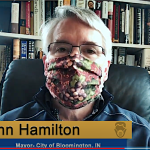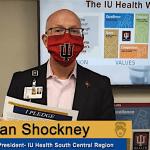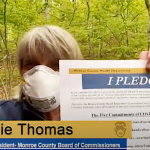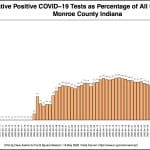Monroe County’s new COVID-19 health order on reopening: Will local officials eat their own cooking?





A new COVID-19 health order issued on Thursday by Monroe County’s health officer Thomas Sharp goes into effect starting Saturday, May 16.
In broad strokes, it puts the county in Stage 2 of Indiana governor Eric Holcomb’s “Back on Track” plan announced on May 1, with a key difference: Monroe County will stay in Stage 2 an extra week compared to the governor’s plan—that is, through May 31.
One effect of the county’s order is that restaurants can open for dine-in services, at 50 percent capacity. Another effect is that barbers and hairstylists can also open for business. Any business that opens has to follow guidelines in the governor’s order.
For “personal services” businesses like barbershops and hair salons, guidelines include accepting customers by appointment only. For all businesses, it means publicly posting a plan for ensuring that customers and employees have a safe environment.
Anecdotally, the feedback that some public officials are getting to the county’s new order is flipped from the reaction they heard about the one issued on May 1. The May 1 directive kept Monroe County buttoned up a couple weeks longer than most of the rest of the state. Two weeks ago, they heard strong objections from those who thought Monroe County was opening up too slow. Now they’re hearing strong objections from people who think Saturday’s reopening is too fast.
Bloomington’s mayor, John Hamilton, expressed his own concerns at Friday’s press conference, saying that many health care experts are warning communities about moving too fast.
Generally, local officials have expressed support for the health officer’s orders as they’ve been issued, in part because their perspective and input has been stirred into the mix of decision making. Will local leaders be eating their own cooking?
When it comes to literal eating, Brian Shockney, president of IU Health’s South Central Region, did not hesitate in response to a question at Friday’s regular press conference. The question from The Square Beacon concerned any immediate plans for using restaurant dine-in services. “It’s going to be Cracker Barrel or Bob Evans, whichever first gets opened and I can get into!” Shockney said.
A Square Beacon phone call to Cracker Barrel confirmed that it would next week before Cracker Barrel opens for dine-in service. Bob Evans will be opening at 7 a.m. Saturday morning for dine-in services, at 50-percent capacity.
Some other leaders on the press conference were not as sanguine about dine-in services in the next couple of days.
Health administrator Penny Caudill said, “We have been supporting our local retail food through takeout and will probably continue to do that over the weekend.” Caudill added, “I can tell you that I certainly am looking forward to the time that I am in a retail establishment eating.”
Bloomington’s mayor, John Hamilton, said, “I certainly welcome the chance for restaurants to move forward safely, but I don’t expect I’ll be doing dine-in.”
Hamilton said he had asked his cabinet the same question the day before on a 20-person Zoom call: Would they be heading right out for dine-in services at a restaurant? “Actually only one or two said they would go out to eat,” Hamilton reported. “I think ‘safer at home’ and doing this incrementally is the way a lot of people are going to approach it,” Hamilton said. He added, “But good luck to all and let’s all be careful.”
President of the county board of commissioners, Julie Thomas echoed Caudill’s sentiments, saying, “I plan to try some more carryout, as well—keep those restaurants going!”
Chuck Carney, Indiana University’s director of media relations, said he had supported National Pizza Day (May 15) earlier that day by going to Cafe Pizzeria for take-out. That’s his favorite local place, he said, adding, “So that’s generally what I would stick to.”
If some local leaders are not exactly exhorting residents to take advantage of the restaurant dine-in services that are made possible in the new health order, they are pushing the “general recommendations” included in the order.
Some of those recommendations have been baked into a five-point pledge they’re promoting.
The Five Commitments of COVID-19 Containment
- I will maintain 6 feet of social distance
- I will wash my hands often for at least 20 seconds
- I will wear a face covering/mask when in public
- I will stay home when I am sick
- I will get tested immediately if I have symptoms
Local leaders are pushing the pledge in a YouTube video.
Two of the points in the pledge came up during the press conference: mask wearing and testing.
Masks
Health administrator Penny Caudill described how she approaches mask wearing. When she’s out alone walking in her neighborhood, the doesn’t wear a mask, she said. But she has her mask with her, so that if she encounters people and can’t maintain a safe six-foot distance, she can put on the mask.
Caudill said that some residents have said they want a government mandate that everyone has to wear a face covering when they’re out in public. One reason not to adopt such a mandate, Caudill said, is that some people have medical circumstances that would preclude wearing a mask. Adequate enforcement capacity is also an issue, Caudill said.
The governor’s “Back on Track” order stops just short of a legal requirement for mask-wearing, using the word “should” instead of “shall.” The order states: “Retail businesses should require employees to wear face coverings and should consider requiring customers to wear face coverings.”
President of the county’s board of commissioners, Julie Thomas, said that when county buildings open up to the public, members of the public will be required to wear a face covering to enter. Reopening of county buildings to the public is not yet scheduled. If someone doesn’t have a mask, they’ll be provided with one, Thomas said.
The same goes for Bloomington’s city hall, according to Mary Catherine Carmichael, the city’s director of public engagement. When the building re-opens to the public, mask-wearing will be required, and if someone doesn’t have a mast, one will be provided. At Friday’s press conference, Mayor Hamilton said city hall would re-open on Tuesday, May 26 in a “limited way.”
Testing
The expanded testing capability that was expected to be provided in Monroe County by OptumServe Health Services starting this past week—as many as 132 tests a day—won’t be deployed until late in the week of May 18, Caudill reported on Friday. The OptumServe testing is being offered at no cost through a partnership with the state.
The reason for the delay, Caudill said, was “challenges” with the original site. Alternative sites had to be reviewed, she said. Once the site is settled on and the testing is available, Monroe County’s health department will publicize that information, Caudill said.
Monroe County’s confirmed COVID-19 case numbers continue to be low—four confirmed cases in the last week. Since April 18 there has not been a day with more than four cases. The average number of confirmed cases over the last 14 days was 1.3 cases. For the 14-day period before that, the average was the same at 1.3 cases a day. For the 14-day period before that the average was nearly five cases a day.
In Monroe County, the percentage of positive tests continues to trend downward. Percentage of positive tests is one of the data points that are part of the Centers for Disease Control “gating criteria” for re-opening.
But the number of cases and the percent of positives could be connected to the low levels of testing. While the number of daily tests done in Monroe County over the last couple weeks has been close to 60, for the last three days, the number of tests reflected in the Indiana State Department of Health dashboard are: 18, 9, and 0 tests done.
When Mayor Hamilton expressed his concerns about moving too fast, he cited the low testing numbers, as well as a recent study done across the state about the prevalence of COVID-19 among residents.
According to the study, done by the Fairbanks School of Public Health at IUPUI, an estimated 186,000 Indiana residents (2.8 percent of the population) were actively or previously infected with COVID-19 as of May 1.
Hamilton pointed out that’s 10 times the number of confirmed cases as of May 1, which was 18,630. The number of confirmed cases statewide has grown in the last two weeks to nearly 27,000.
Hamilton asked residents to be patient, as modification to the health orders could be possible in the future, saying it’s important to “give the data time to catch up.”


[Updated on May 17, 2020 at 12:55 p.m. Six new confirmed cases were reported for Monroe County on the state’s COVID-19 dashboard for Saturday, May 16. That’s the most for Monroe County on a single day in about a month.]
Updated Chart from May 17, 2020

Age Distribution of Monroe County Confirmed COVID-19 Cases
Based on the age distribution data available the day before and the current data as of May 16, 2020, the six new cases can be calculated to belong in the following age ranges.
| Age Range | New Cases Reported May 16, 2020 |
| 0-19 | 0 |
| 20-29 | 1 |
| 30-39 | 3 |
| 40-49 | 1 |
| 50-59 | 1 |
| 60-69 | 0 |
| 70-79 | 0 |
| 80+ | 0 |




Comments ()